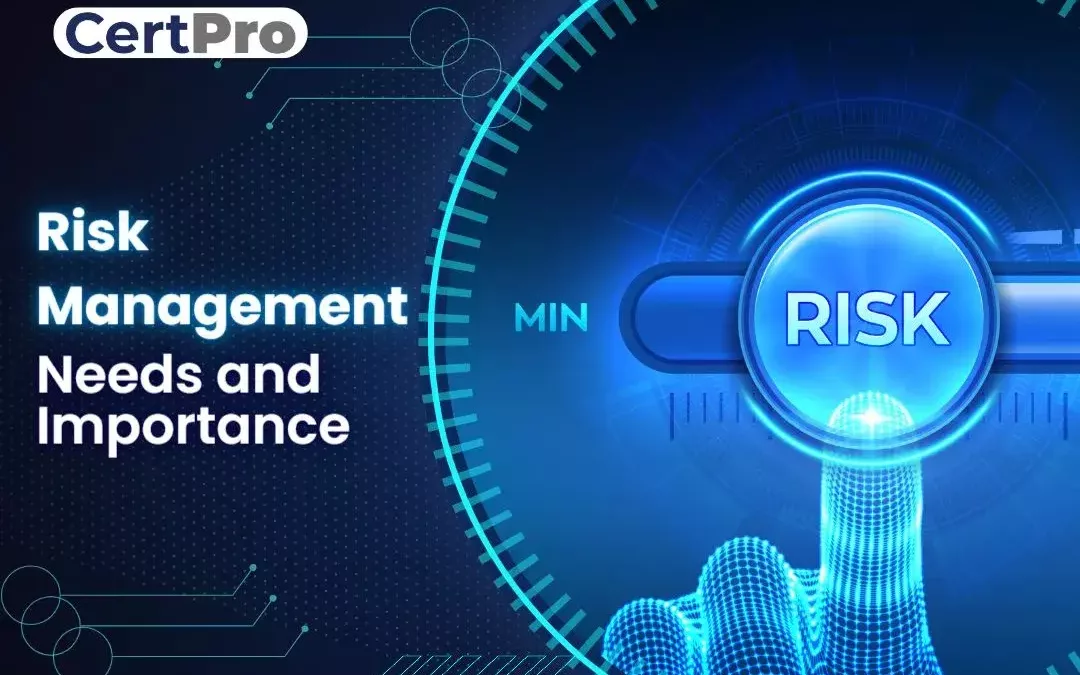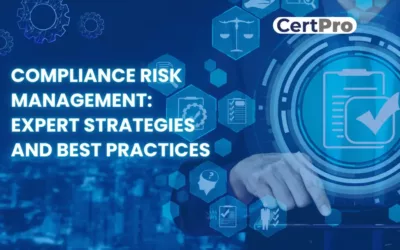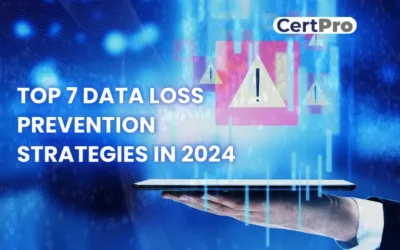The systematic process of discovering, analyzing, and managing possible threats to corporate objectives is called risk management. It entails understanding uncertainties and making educated judgments in order to reduce the negative impact of unforeseen events. Risk measures is a continuous activity that needs constant monitoring and evaluation. Organizations must adjust their strategies when new risks emerge or old ones alter. Regularly assessing risk management techniques ensures their efficacy and allows firms to adapt proactively to developing threats.
In this article, let’s get to know the need and importance of risk management and also about risk assessment management because, ultimately, good risk management helps businesses negotiate uncertainty, capitalize on opportunities, and safeguard their assets, reputation, and long-term viability.
WHAT IS RISK MANAGEMENT?
Risk management is a systematic process that identifies, assesses, and manages possible risks to an organization or people. It entails a number of processes that begin with identifying and recording the numerous hazards that may represent a danger, both internal and external. These hazards are then evaluated based on their likelihood and possible impact. This assists in prioritizing risks and determining the best tactics for mitigating or managing them. Implementing methods to lower the likelihood of risks arising, preparing contingency plans to address them if they do arise, and regularly monitoring and assessing the risks and their management techniques are all part of risk management. Effective risk management helps firms deal with uncertainty proactively, preserve assets, limit losses, and maximize opportunities.
It begins with the identification and evaluation of possible threats. This entails carefully identifying all potential hazards to the company or individual, both inside and outside. Once identified, the risks are assessed based on their chance of occurrence and possible effect. This stage aids in risk prioritization, allowing for a more concentrated approach to risk management.
Second, risk management entails putting methods in place to minimize or manage the identified risks. This involves creating and executing preventative steps to lower the likelihood of risks arising, making contingency plans to effectively respond to risks if they do arise, and transferring some risks via insurance or contracts. The methods that have been established are constantly evaluated and assessed to verify their efficacy and adapt to changes in the risk landscape. Furthermore, effective communication of risk-related information to stakeholders is critical for raising awareness and knowledge of possible risks and the measures being taken to manage them. Overall, risk management is an important process that assists businesses and individuals in navigating uncertainties and making educated decisions in order to protect themselves and optimize results.
THE TYPES OF RISK MANAGEMENT
Organizations use many methods of risk management to address various areas of possible hazards. A few risk management types are:
- Financial risk management: It is concerned with identifying and controlling financial risks that may have an influence on an organization’s financial well-being. Risks associated with market swings, credit defaults, liquidity, interest rates, currency exchange rates, and investment portfolios are all included. Hedging, diversification, and the use of financial instruments such as derivatives are all common components of financial risk measures management methods.
- Operational risk management: This is concerned with the hazards associated with an organization’s internal processes, systems, and procedures. Human mistakes, technological failures, supply chain interruptions, fraud, legal and compliance concerns, and natural calamities are all examples of hazards. Through adequate controls and contingency plans, operational risk measures aims to assure the continuity of operations, limit losses, and increase efficiency.
- Strategic risk management: This type of risk management entails recognizing and mitigating risks that may have an influence on an organization’s long-term objectives and strategic direction. It focuses on market dynamics, the competitive landscape, technological innovations, the regulatory environment, and geopolitical considerations. Strategic risk management assists firms in identifying opportunities, making educated decisions, and adapting their plans to deal with uncertainty.
- Reputational risk management: It is concerned with safeguarding and strengthening an organization’s reputation and brand value. It entails detecting threats to the organization’s image, trustworthiness, and stakeholder relationships. Public relations disasters, product recalls, unethical conduct, social media reactions, and unpleasant consumer experiences can all pose reputational hazards. Proactive communication, ethical behavior, strong customer connections, and crisis management processes are all components of effective reputation risk management.
It is crucial to remember that various risk management approaches are not mutually exclusive and frequently overlap. Organizations often use a combination of risk management measures that are adapted to their unique needs and industry standards.
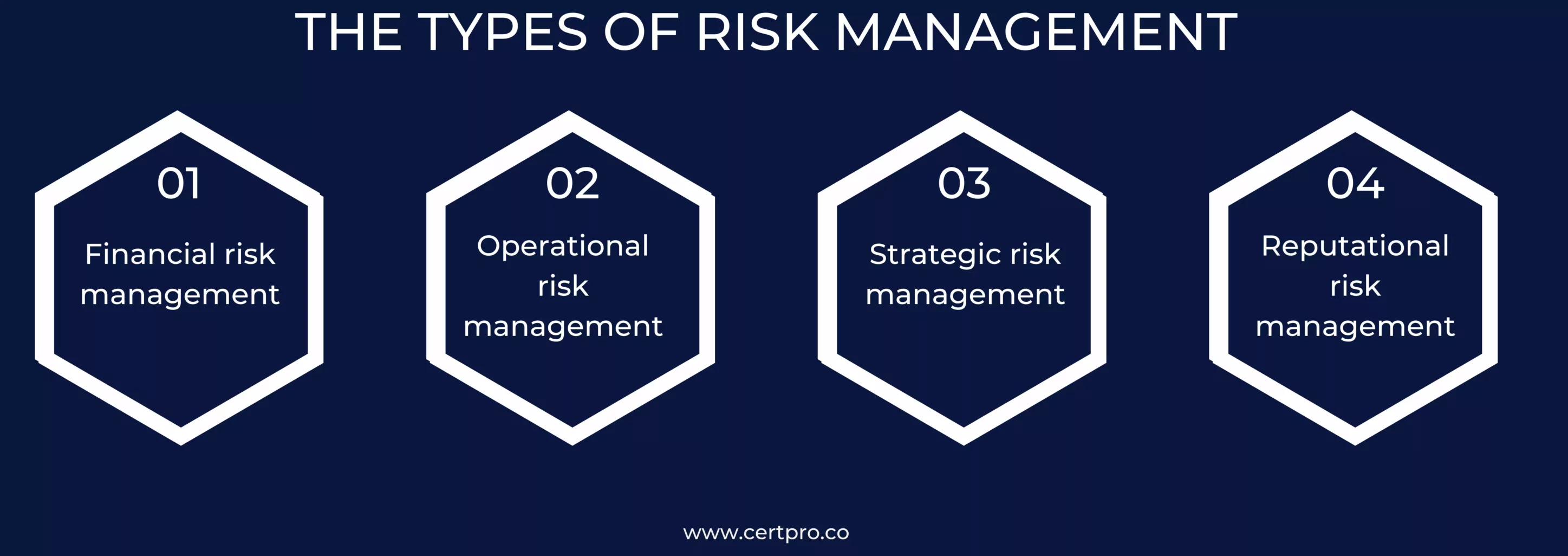
WHY IS IT IMPORTANT?
Risk management is essential for a number of reasons. For starters, it aids in the protection of an organization’s assets and resources. Organizations may reduce possible losses and avert costly harm to their financial resources, physical infrastructure, intellectual property, and brand reputation by detecting and mitigating risks. Second, risk management assures the continuance of corporate operations. It lets firms handle risks proactively, build contingency plans, and put protections in place to ensure continuous operations. This capacity to deal with unforeseen occurrences or disruptions is critical for maintaining customer satisfaction, completing contractual responsibilities, and remaining competitive in the market.
Furthermore, risk measures is critical in decision-making processes. Organizations may make educated decisions by knowing possible risks and their potential consequences. Strategic planning, resource allocation, and project management are all aided by risk analysis. Furthermore, risk management assists firms in meeting regulatory and legal requirements. Organizations may show compliance, mitigate legal penalties, and retain their reputation by recognizing and resolving risks that could lead to legal or regulatory infractions.
Finally, good risk management instills trust in stakeholders. It illustrates that firms are proactive in detecting and managing risks, as well as instilling trust in consumers, investors, workers, and suppliers. Organizations that have a strong risk management framework in place can negotiate uncertainties, capitalize on opportunities, and achieve their goals while guaranteeing long-term sustainability.
WHY DO WE NEED IT?
Risk management is the systematic process of discovering, analyzing, and prioritizing risks, as well as applying risk mitigation or risk management solutions. It is a crucial activity for both businesses and people because it allows them to handle possible dangers and uncertainties that may damage their objectives, initiatives, or operations in advance. Here are some of the reasons why risk management is necessary:
Minimizing losses: Risk management assists in detecting and assessing possible risks that might result in financial, operational, or reputational losses. Organizations can lessen the possibility and severity of such losses by employing proper risk mitigation methods.
Enhanced decision-making: Effective risk assessment management gives useful insights into possible hazards and their potential consequences. This knowledge helps decision-makers make educated decisions by taking into account the possible risks and rewards of various solutions.
Protecting Reputation: If risks are not adequately handled, they can harm an organization’s reputation. Organizations may preserve their image, reputation, and brand value by proactively recognizing and managing threats.
Ensuring compliance: Risk management assists firms in identifying regulatory requirements and ensuring compliance with laws, rules, and industry standards. Organizations may avoid legal penalties, fines, and brand loss by controlling compliance risks.
Improving Operational Efficiency: Effective risk assessment management methods aid in the identification of inefficiencies, weaknesses, and possible business disruptions. Organizations may streamline their processes, increase resource allocation, and improve overall operational efficiency by addressing these risks.
Long-term Sustainability: It is facilitated by risk management, which fosters a proactive and forward-thinking approach, helping firms anticipate and adapt to changing conditions. Organizations may improve their resilience and long-term sustainability by detecting new threats and creating contingency plans.
Overall, risk management is critical for companies and individuals in an increasingly complex and dynamic world to navigate uncertainty, safeguard their interests, and make educated decisions. It promotes stability, resilience, and development while mitigating any negative consequences.
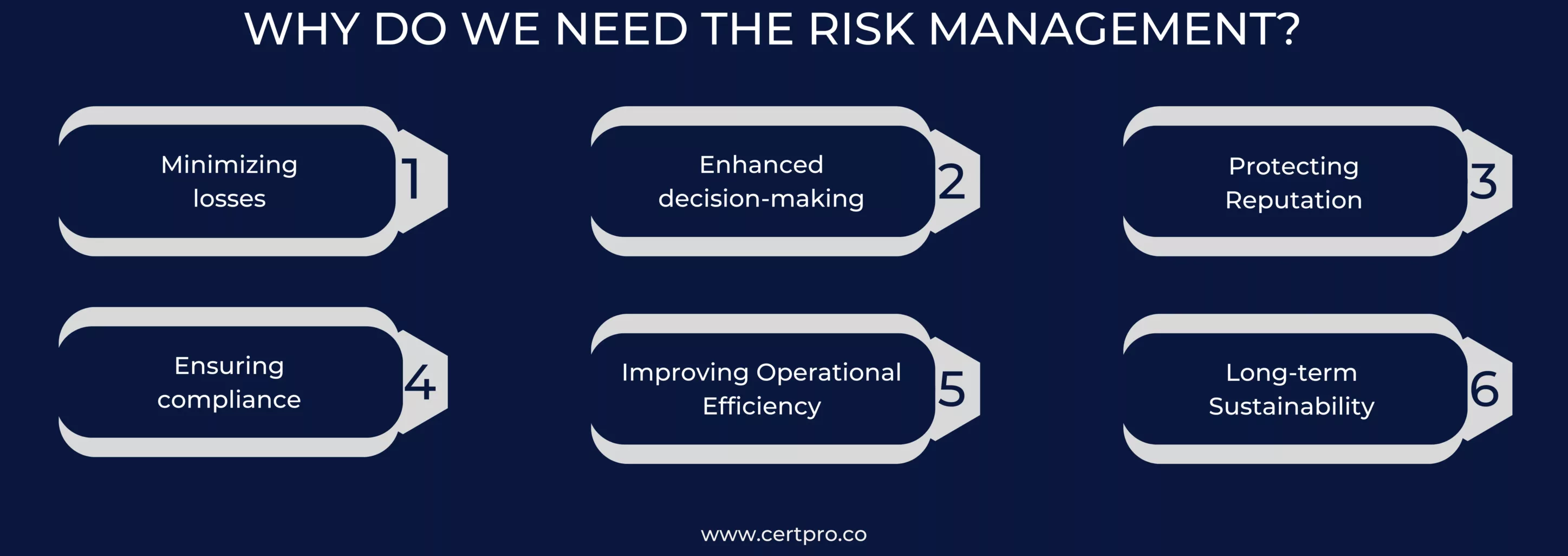
SAFEGUARD YOUR ORGANIZATIONS WITH CERTPRO
Risk assessment management is an essential strategy that protects companies and individuals from possible dangers and uncertainties. Organizations may reduce losses, improve decision-making processes, protect their brand, maintain compliance, and increase operational efficiency by employing a structured and methodical approach to detecting, analyzing, and managing risks.
Risk management also instills trust in stakeholders, allows for the capture of opportunities, and promotes long-term sustainability. Organizations may expedite their risk assessment and mitigation processes with the help of tools and solutions such as CertPro, a comprehensive risk management platform, boosting their capacity to proactively handle and manage risks efficiently. Organizations may traverse the volatile business landscape with more confidence, resilience, and success by embracing risk management approaches and employing sophisticated technology.
FAQ
What is the function of CertPro in risk management?
CertPro is an all-in-one risk management platform that helps businesses streamline their risk assessment and mitigation operations. It provides sophisticated tools and solutions to improve the efficacy of risk management methods.
What role does risk management play in long-term sustainability?
Risk management encourages a proactive and forward-thinking approach, allowing firms to anticipate and react to changing conditions. It aids in the identification of new hazards, the development of contingency plans, and the enhancement of long-term sustainability.
How frequently should risk assessments be performed?
Risk assessments should be performed on a regular basis and anytime substantial changes occur in the operations, projects, or external environment of the business. This guarantees that hazards are constantly assessed and handled.
Is risk management limited to large corporations?
No, risk management applies to firms of all sizes and in a variety of sectors. Small and medium-sized businesses (SMEs) can benefit from risk management methods that are adapted to their individual requirements and resources.
Can risk management aid in the reduction of insurance costs?
Yes, good risk management has the ability to lower insurance prices. Organizations that demonstrate proactive risk management techniques can negotiate cheaper insurance premiums and conditions because insurers see them as lower-risk entities.

About the Author
NICOLENE KRUGER
Nicolene Kruger, Regional Manager in South Africa, is an experienced Legal Counsel with expertise in compliance and auditing. Her strategic, solution-driven approach aligns legal standards with business objectives, ensuring seamless adherence to regulations.
COMPLIANCE RISK MANAGEMENT: EXPERT STRATEGIES AND BEST PRACTICES
Compliance risk considers the organization's potential legal, material, and financial losses due to compliance failure. Thus, compliance risk is known as integrity risk. Organizations of all sizes are exposed to compliance risk. Hence, compliance failure results in...
TOP 7 DATA LOSS PREVENTION STRATEGIES IN 2024
In the contemporary business landscape, data is the cornerstone of organizational vitality. Businesses leverage data extensively to inform decisions, maintain competitiveness, and foster expansion. Nonetheless, they encounter multifaceted challenges emanating from...
TIPS FOR ARTICULATING YOUR SECURITY POSTURE TO STAKEHOLDERS
Cybersecurity is now a top-tier priority for any Organization. Data breaches can ruin the entire company, destroy customer trust, and damage reputation. However, companies can find decision-making difficulties because stakeholders, board members, department heads, and...

